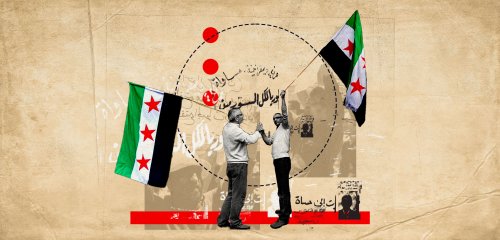What is happening on the Syrian coast today? It’s a question that has divided Syrians sharply — a division that is neither fleeting nor sudden. The living conditions in Syria for decades indicate that society, both before the revolution and during its early days and aftermath, was never free from the sense of dominance by certain groups over others. This inevitably led to a growing feeling of injustice, which gradually intensified, widening the sectarian rift more than anything else.
Those who raised questions regarding the future of Syria following the fall of Bashar al-Assad were told they were rushing to judgment and should wait and see before making any "premature conclusions." As a result, an atmosphere prevailed that discouraged thinking about what was to come, or predicting the future based on the history of the new authority and its practices during the prolonged years of war.
The revolution, which began with the slogan “One, One, One! The Syrian People Are One!” ultimately failed to erase or deny the reality that dominance inevitably invites attempts to break it—in retaliation for the years of suffering endured by the “oppressed sect.”
The new reality that imposed itself on December 8th, following the fall of Bashar al-Assad's regime, opened the door to many questions. Those who raised them at the time were told they were rushing to judgment and should wait and see before making any "premature conclusions." As a result, an atmosphere prevailed that restricted and discouraged thinking about what was to come, or predicting the future based on the history of the new authority and its practices during the prolonged years of war across various regions of Syria.
Perhaps many who initially censored those who spoke out about the new ruling authority may not have intended to be oppressive. Many of them believed, and still believe—or once believed but later changed their minds—that the changes they saw within the groups that overthrew the regime, along with their leader, was a promising sign. This was especially true when they observed the way these groups behaved in an unexpectedly restrained manner after the fall of the regime and its remnants, which seemed uncharacteristic of these groups. It was as though the temptations and allure of power had reshaped the mindset of the majority toward the members of the sect that had previously held dominance.
In the period leading up to the recent events and following the fall of the regime, the new ruling authority made no serious effort to ensure a smooth transition toward a new phase that embodied slogans for ‘A Syria for all its people.’ Instead, it preoccupied itself with securing its rule and that of its leader at the top of the hierarchy.
The indicators of today’s reality did not begin with the ambush set by “remnants of the former regime”— an act that is merely a continuation of their desperate clinging to power, something the previous regime and its loyalists have long been accustomed to. From its very first days, the new authority in Damascus dealt with a degree of denial regarding the reality that it is responsible for all Syrians, and not just its supporters.
In its public discourse and official rhetoric, there was plenty of talk about Syria’s unity and that Syria belongs to all its people. However, in practice, none of this was reflected — from the formation of the government to the national conference and even certain institutional structures aimed at consolidating a new form of dominance. At best, what has transpired has laid the groundwork for a vengeful sentiment among many groups that lost their grip on power when Assad abandoned them to face their fate alone—after he had forcibly, and often against their will, cemented the notion that they bore collective responsibility for what happened to other Syrians over the past years.
In the period leading up to the recent events and following the fall of the regime, the new ruling authority made no serious effort to ensure a smooth transition toward a new phase that embodied slogans for ‘A Syria for all its people.’ Instead, it preoccupied itself with securing its rule and that of its leader at the top of the hierarchy, believing that the political signals from regional and international powers involved in the Syrian situation were sufficient to guarantee a calm and stable period.
It also assumed that justice could be delayed for years—if there was ever an intention to achieve justice and redress grievances at all. Meanwhile, “remnants of the old regime” were given space to reorganize themselves under the new authority, which sought to appease them and sent multiple signals reassuring them that their interests would be safeguarded, albeit in different forms.
Those who seized power fell into the trap of willful blindness. This is likely deeply connected to the nature of this new authority, which is composed mostly of sectarian groups—some of which are not even Syrian—who have long fought under various banners and view other sects in a way that is entirely inconsistent with the slogan "A Syria for all its people."
Beyond all this, no real consideration was given to what might unfold during this period. The warlords who had lost their positions would not simply return home and wait for the day they would be held accountable for their actions against Syrians. At the same time, those who seized power fell into the trap of willful blindness. This is likely deeply connected to the nature of this new authority, which is composed mostly of sectarian groups—some of which are not even Syrian—who have long fought under various banners and view other sects in a way that is entirely inconsistent with the slogan "A Syria for all its people." This was starkly evident in the sectarian rhetoric that has accompanied the fighting and deliberate killings in the cities and towns of the Syrian coast, where the majority of the population belongs to the Alawite sect.
Discussions about the new authority were either postponed or outright suppressed, one way or another, and today, it is unfolding over a bloodbath. But at best, this is not a genuine discussion—it is a reality where entire groups are being subjected to oppression and killings solely because they belong to the defeated sect, even if these groups were opposed to the previous regime, which is what, in fact, happened. Meanwhile, there are other groups that insist on the sanctity of Syrian blood, particularly that of innocent civilians, and denounced the collective acts of revenge that were taking place.
Among the many factions involved, there are also other groups that have now transformed into the enforcers and supporters of the new authority, demanding it strike with fire and an iron fist, and to "kill those who killed them" in the past, even if many innocent victims, who have no fault in what has happened or is happening, fall along the way.
What happened on the Syrian coast was not merely a response to an ambush by “the remnants of the regime.” It is an act of vengeance and sectarian cleansing, pushing justice further out of reach for the new authority and opening the door to chaos involving multiple actors—both local and international.
The period between December 8 and last week has drawn the lines of responsibility for each party—foremost among them, the new authority—in what has become of the "new Syria," which lacks even the minimum ability to achieve transitional justice, both morally and materially. The bulk of the responsibility falls on the new authority, as the so-called "legitimate government" that claimed to represent "all Syrians." However, this promise has not been fulfilled, nor does it seem likely to be realized in the near or medium term. This is because it practices or allows the dominance of a sect that was once oppressed, but has now taken on the role of the avenger, rather than the architect shaping a future full of less hatred and misery than the reality that existed under “Baathist rule.”
What was happening on the Syrian coast was not merely a response to an ambush by “the remnants of the regime.” It is an act of vengeance and sectarian cleansing, pushing justice further out of reach for the new authority and opening the door to chaos involving multiple actors—both local and international. And the Syrians will have no role in it nor in determining their fate, which, it seems, will remain suspended indefinitely, or at least until yet another agreement “from above” is reached once again.
*The views and opinions expressed in this article are those of the author’s and do not necessarily reflect the official policy or position of Raseef22
Raseef22 is a not for profit entity. Our focus is on quality journalism. Every contribution to the NasRaseef membership goes directly towards journalism production. We stand independent, not accepting corporate sponsorships, sponsored content or political funding.
Support our mission to keep Raseef22 available to all readers by clicking here!
Interested in writing with us? Check our pitch process here!




